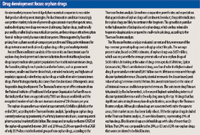Strategies in API Scale Up
Process chemists employ a variety of approaches to improve yield, purity, and stereoselectivity.
Synthetic organic chemists in the pharmaceutical and fine-chemical industries seek advances to help improve yield, purity, and stereoselectivity of intermediates and APIs. This goal takes route in a multitude of ways from general advances in organic chemistry to reaction-specific gains. Advances in asymmetric synthesis are of particular importance given the prevalence of chiral compounds as potential drug candidates and the attendant interest in producing single enantiomers. This objective has to be met with the ability to scale up any given stereoselective synthesis for commercial manufacture, and several interesting developments have made in this area. Production economics also are a consideration as well in scaling up reactions to commercial levels. A cost-effective route to the antimalarial drug artemisinin, and a biocatalytic route for aromatic nitration reactions are some recent developments.

PHOTODISC/THINKSTOCK IMAGES
Asymmetric synthesis
Enantioselective imine-cyanation/Strecker reaction. Researchers at the Institute of Chemical and Engineering Sciences, a national research institute under Singapore's Agency for Science, Technology and Research, recently reported on a robust new catalyst that selectively generates amino-acid precursors from cyanide at room temperature at an industrial scale. Specifically, they reported on a new catalyst more amenable to scale-up in the asymmetric Strecker reaction, a heterogeneous self-supported chiral titanium cluster (SCTC) catalyst in the enantioselective imine–cyanation/Strecker reaction used in both batch and continuous processes (1, 2). A limitation in the asymmetric Strecker reaction is the lack of availability of efficient and reusable heterogeneous catalysts that work at room temperature. The researchers took advantage of the hydrolyzable nature of titanium alkoxide to synthesize a SCTC catalyst by the controlled hydrolysis of a preformed chiral titanium–alkoxide complex (2). The researchers reported that the isolated SCTC catalysts were stable and showed up to 98% enantioselectivity with complete conversion of the imine within two hours for a wide variety of imines at room temperature. Moreover, the heterogeneous catalysts were recyclable more than 10 times without any loss in activity or selectivity (2).

Patricia Van Arnum
The researchers reported that the catalyst was used in a packed-bed reactor to carry out the cyanation under continuous flow with up to 97 % enantioselectivity under optimized flow conditions at room temperature in the case of benzhydryl imine. A three-component Strecker reaction also was performed under continuous flow by using the corresponding aldehydes and amines instead of the preformed imines under which good product distribution was obtained for the formation of amino nitriles with enantioselectivity values of up to 98% (2).
All-carbon quaternary stereogenic centers in acyclic systems. A team of researchers led by Ilan Marek, professor at the Technion–Israel Institute of Technology in Haifa, described their work in forming all-carbon quaternary stereogenic centers in acyclic systems from alkynes (3). Construction of chiral all-carbon quaternary centers had been limited in previous aldol-based methodologies, according to a Nov. 28, 2012, Technion–Israel Institute of Technology press release. The researchers used a single-pot operation, starting from classical hydrocarbons, to form aldol products containing the desired all-carbon quaternary stereocenter through the concomitant formation of three new bonds, according to the release. A challenge in forming the all-carbon quaternary stereocenters in acyclic systems had been the preparation of all-carbon quaternary stereocenters in aldol adducts (3). The main problem that limits the formation of these stereocenters is the absence of an efficient method of preparing stereodefined trisubstituted enolates in acyclic systems. The researchers developed a different approach that involves the formation of two new stereogenic centers, including the all-carbon quaternary one, through a combined carbometalation–oxidation reaction of an organocuprate to give a stereodefined trisubstituted enolate (3). The researchers used this method to generate a series of aldol and Mannich products from ynamides. For his work in organic synthesis, Marek received the Royal Society Chemistry Organometallic Award in 2011 and the Janssen Pharmaceutica Prize for Creativity in Organic Synthesis in 2012.
Asymmetric carbon–hydrogen functionalization. Researchers at the Ecole Polytechnic Fédérale de Lausanne, School of Basic Sciences, Institute of Chemical Sciences and Engineering, Laboratory of Asymmetric Catalysis and Synthesis, in Lausanne, Switzerland, recently reported on the development of chiral cyclopentadienyl ligands as stereocontrolling elements in asymmetric carbon–hydrogen functionalization. The researchers sought to tackle a limitation in the application of metal complexes coordinated by a single cyclopentadienyl ligand as a catalyst in asymmetric reactions (4). The difficulty, they reported, has been designing cyclopentadienyl substituents that bias the coordination sphere. The researchers developed a class of C2-symmetric cyclopentadienyl derivatives that control the spatial arrangement of the transiently coordinated reactants around the central metal atom by developing rhodium (III) complexes with these ligands as highly enantioselective catalysts for directed carbon–hydrogen bond functionalizations of hydroxamic acid derivatives (4).
Scale-up of artemisinin
A cost-effective, large-scale synthesis for the natural product artemisinin, an antimalarial treatment, has been elusive, but researchers at the Indiana University (IU) developed a new approach that is moving toward that goal. The World Health Organization has set a target-per-gram cost for artemisinin of 25 cents or less, but the current cost is about $2.40 per gram, according to a Sept. 12, 2012, IU press release. "In 2005, the WHO claimed that the structure of artemisinin was too complex for cost-effective synthesis," said IU Bloomington College of Arts and Sciences chemistry professor Silas Cook, in the IU release.
Silas and other IU researchers' cost-effective approach to artemisinin uses cyclohexenone as a key starting material and basis for developing reaction cascades in producing artemisinin in a five-pot sequence on a gram
scale (5). "The key to the ultimate success of synthetic artemisinin will be the large-scale production of the drug," Cook said in the IU release. "As such, we had to completely rethink what qualified as suitable starting materials for this synthesis and invent new chemistry." The next challenge will be to move from gram-scale to kilogram-scale production.
Aromatic nitration reactions
Biocatalysis can play an important role in synthetic chemistry by providing more efficient chemical transformations and improving process conditions. Such is the case for chemists at the University of Warwick in the United Kingdom, who in collaboration with researchers at Cornell University in New York, recently reported on the discovery of an enzyme in the bacterium Streptomyces scabies that catalyzes an aromatic nitration reaction (6).
The researchers assert that TxtE, a cytochrome P450 enzyme, is the first example of an enzyme that has specifically evolved to catalyze an aromatic nitration reaction, according to a Sept. 21, 2012, University of Warwick, press release. It does this by using the gases nitrogen monoxide, generated from the amino acid arginine by the nitric oxide synthase partner enzyme txtD, and dioxygen. Engineering of the TxtE enzyme may allow it to be developed as a nitration biocatalyst for the production of industrial chemicals without the need to use nitric acid.

Drug development focus: orphan drugs
Cytochrome P450 enzymes are widespread in living organisms. Usually, they are responsible for hydroxylation and other oxidative reactions, but this is the first time that they have been reported to catalyze a nitration reaction, according to the researchers. TxtE catalyzes the introduction of a nitro group into a specific position of the aromatic ring of the amino acid tryptophan. This is the first key step in the biosynthesis of thaxtomin A.
Patricia Van Arnum is a executive editor of Pharmaceutical Technology, 485 Route One South, Bldg F, First Floor, Iselin, NJ 08830
tel. 732.346.3072, pvanarnum@advanstar.com. twitter@PharmTechVArnum
References
1. "Catalyst: Putting Cyanide to Work", A*Star Research, online, www.research.a-star.edu.sg/research/6566, Oct. 10, 2012.
2. A.M. Seayad et al., Chemistry–A European Journal 18 (18), 5693–5700 (2012).
3. I. Marek et al, Nature 490 (7421), 522–526 (2012).
4. B.E. and N. Cramer, Science 338 (6106), 504–506 (2012).
5. C. Zhu and S.P. Cook. J. Am. Chem. Soc. 134 (33), 13577–13579 (2012).
6. G. Challis, Nature Chem. Biol. 8 (10), 814–816 (2012).

Drug Solutions Podcast: A Closer Look at mRNA in Oncology and Vaccines
April 30th 2024In this episode fo the Drug Solutions Podcast, etherna’s vice-president of Technology and Innovation, Stefaan De Koker, discusses the merits and challenges of using mRNA as the foundation for therapeutics in oncology as well as for vaccines.